Business Communication for Managers: Crisis Management and Effective Communication
VerifiedAdded on 2023/05/30
|12
|2494
|273
AI Summary
This report elaborates on two articles that suggest effective communication and crisis management strategies for businesses. It highlights the importance of employee participation, mutual sharing of knowledge, and effective communication between employees and managers. The report also establishes a relationship between crisis responsibility and organizational reputation, emphasizing the role of charismatic leadership communication in mitigating crises.
Contribute Materials
Your contribution can guide someone’s learning journey. Share your
documents today.
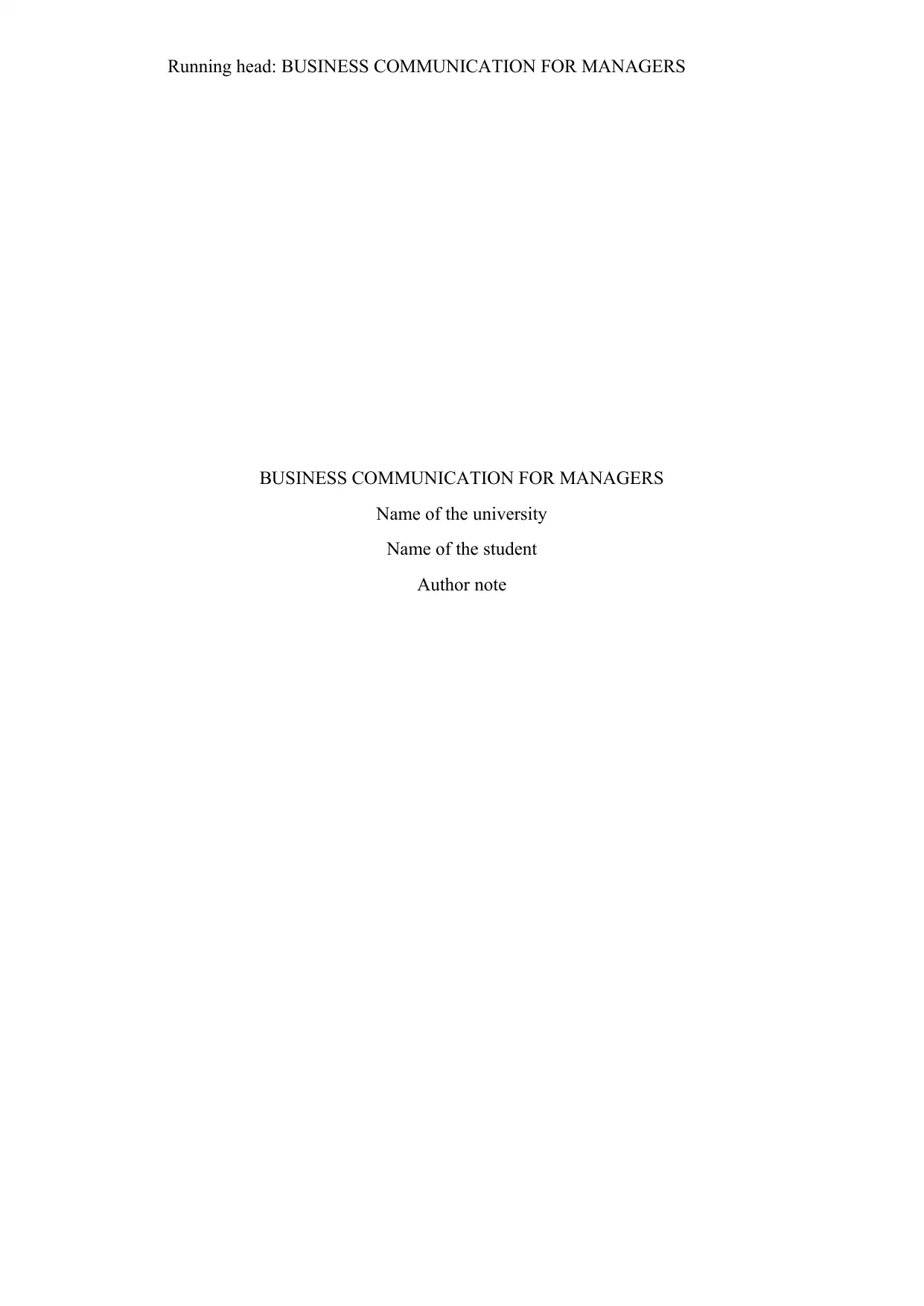
Running head: BUSINESS COMMUNICATION FOR MANAGERS
BUSINESS COMMUNICATION FOR MANAGERS
Name of the university
Name of the student
Author note
BUSINESS COMMUNICATION FOR MANAGERS
Name of the university
Name of the student
Author note
Secure Best Marks with AI Grader
Need help grading? Try our AI Grader for instant feedback on your assignments.
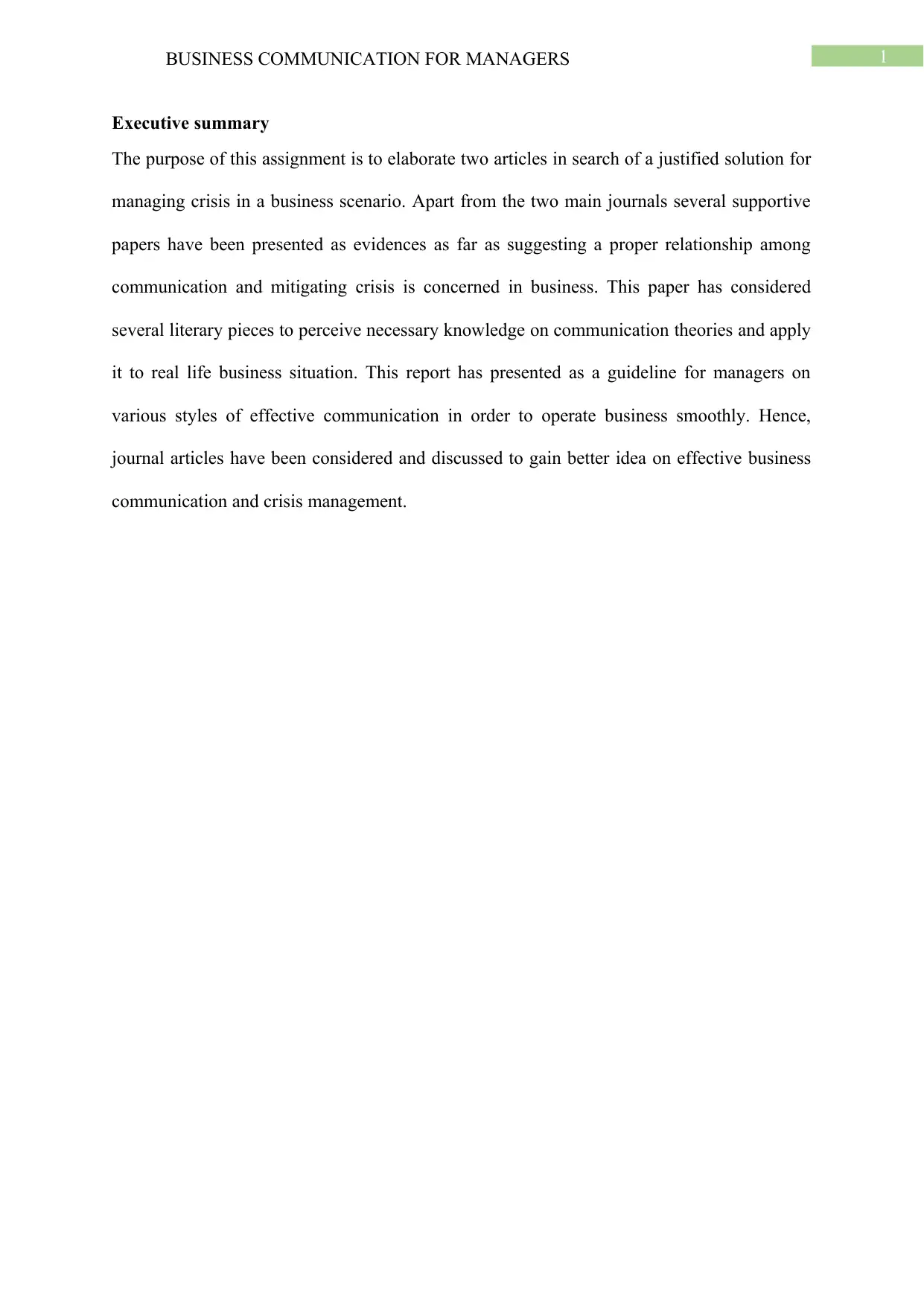
1BUSINESS COMMUNICATION FOR MANAGERS
Executive summary
The purpose of this assignment is to elaborate two articles in search of a justified solution for
managing crisis in a business scenario. Apart from the two main journals several supportive
papers have been presented as evidences as far as suggesting a proper relationship among
communication and mitigating crisis is concerned in business. This paper has considered
several literary pieces to perceive necessary knowledge on communication theories and apply
it to real life business situation. This report has presented as a guideline for managers on
various styles of effective communication in order to operate business smoothly. Hence,
journal articles have been considered and discussed to gain better idea on effective business
communication and crisis management.
Executive summary
The purpose of this assignment is to elaborate two articles in search of a justified solution for
managing crisis in a business scenario. Apart from the two main journals several supportive
papers have been presented as evidences as far as suggesting a proper relationship among
communication and mitigating crisis is concerned in business. This paper has considered
several literary pieces to perceive necessary knowledge on communication theories and apply
it to real life business situation. This report has presented as a guideline for managers on
various styles of effective communication in order to operate business smoothly. Hence,
journal articles have been considered and discussed to gain better idea on effective business
communication and crisis management.
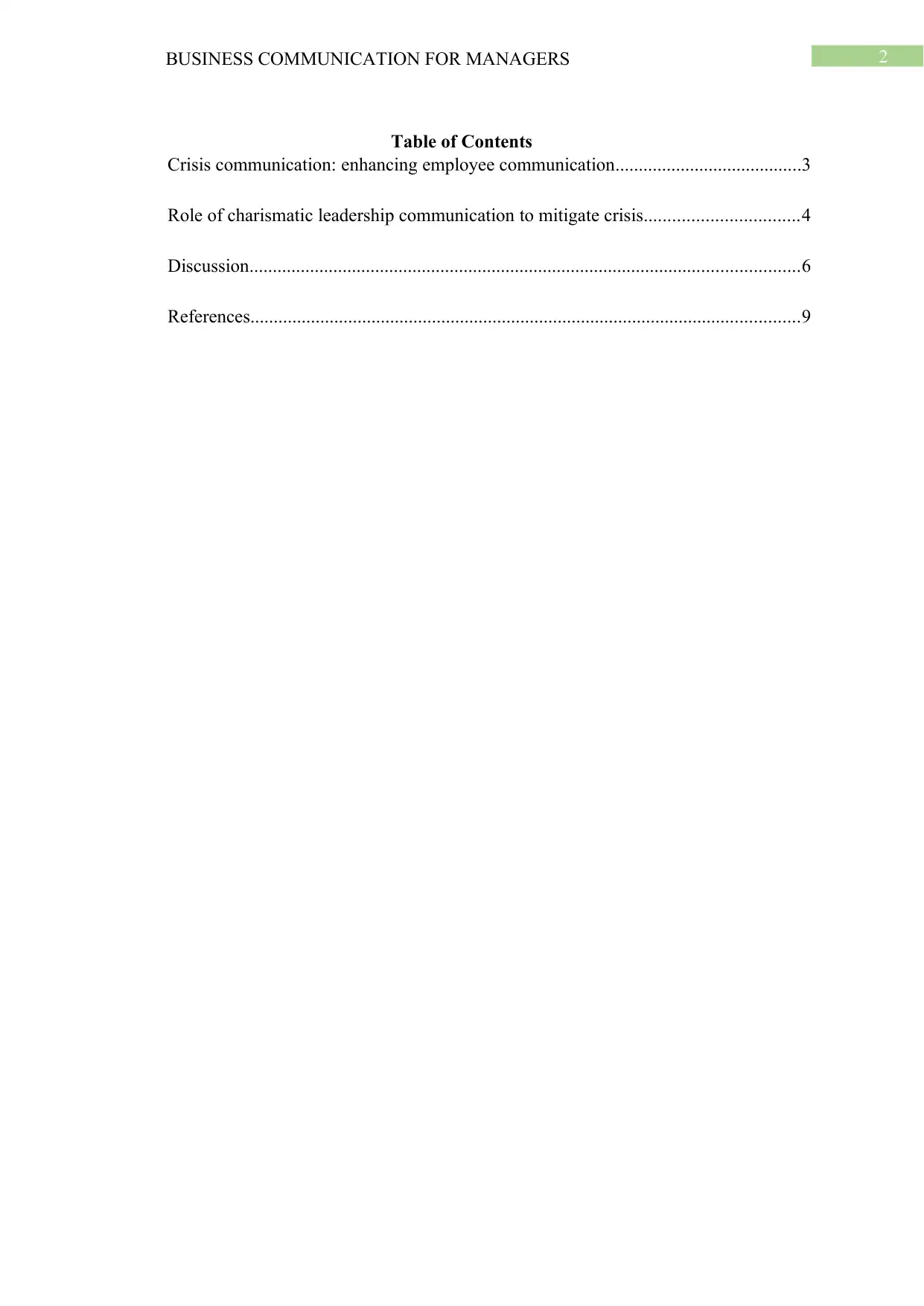
2BUSINESS COMMUNICATION FOR MANAGERS
Table of Contents
Crisis communication: enhancing employee communication........................................3
Role of charismatic leadership communication to mitigate crisis.................................4
Discussion......................................................................................................................6
References......................................................................................................................9
Table of Contents
Crisis communication: enhancing employee communication........................................3
Role of charismatic leadership communication to mitigate crisis.................................4
Discussion......................................................................................................................6
References......................................................................................................................9
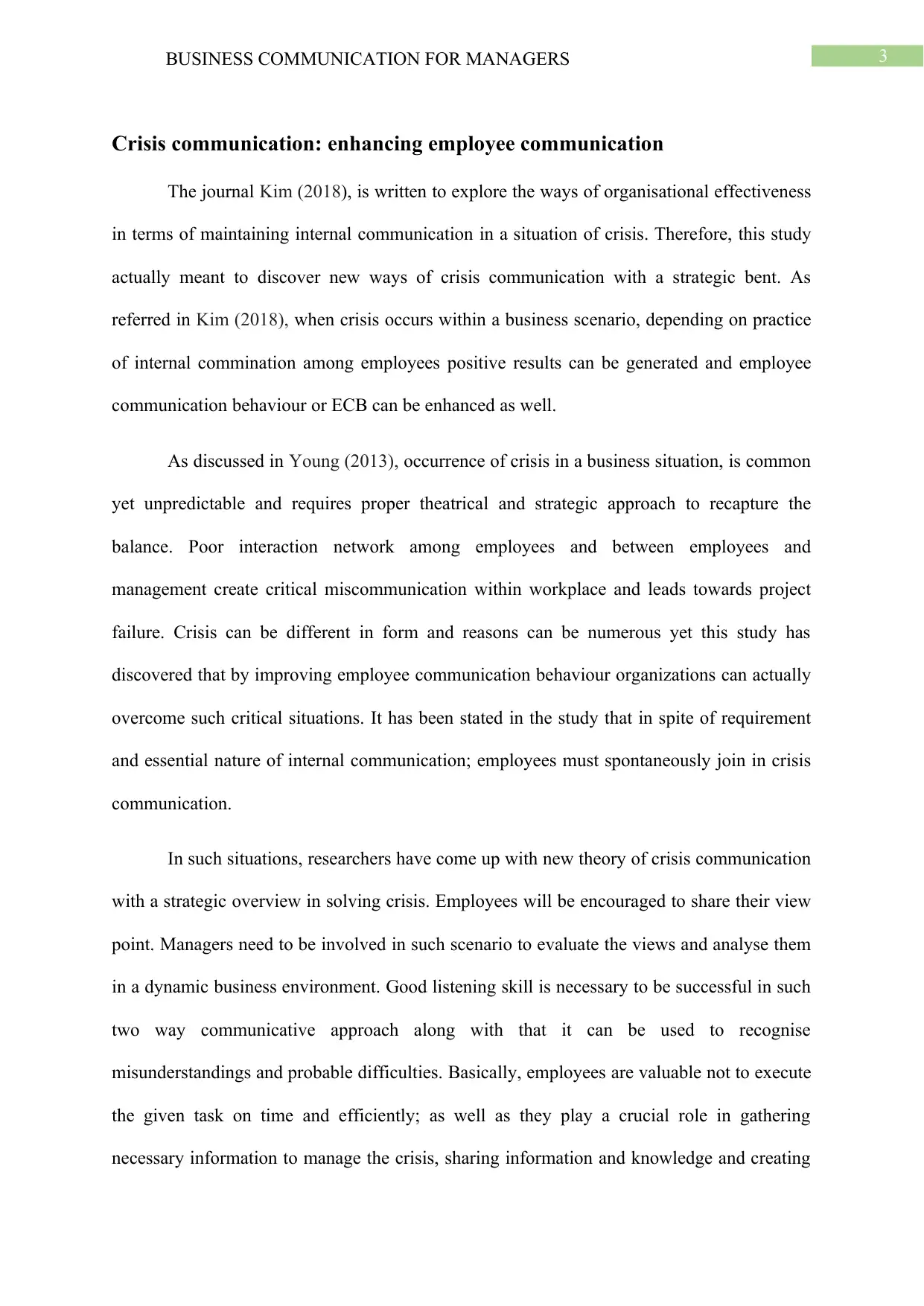
3BUSINESS COMMUNICATION FOR MANAGERS
Crisis communication: enhancing employee communication
The journal Kim (2018), is written to explore the ways of organisational effectiveness
in terms of maintaining internal communication in a situation of crisis. Therefore, this study
actually meant to discover new ways of crisis communication with a strategic bent. As
referred in Kim (2018), when crisis occurs within a business scenario, depending on practice
of internal commination among employees positive results can be generated and employee
communication behaviour or ECB can be enhanced as well.
As discussed in Young (2013), occurrence of crisis in a business situation, is common
yet unpredictable and requires proper theatrical and strategic approach to recapture the
balance. Poor interaction network among employees and between employees and
management create critical miscommunication within workplace and leads towards project
failure. Crisis can be different in form and reasons can be numerous yet this study has
discovered that by improving employee communication behaviour organizations can actually
overcome such critical situations. It has been stated in the study that in spite of requirement
and essential nature of internal communication; employees must spontaneously join in crisis
communication.
In such situations, researchers have come up with new theory of crisis communication
with a strategic overview in solving crisis. Employees will be encouraged to share their view
point. Managers need to be involved in such scenario to evaluate the views and analyse them
in a dynamic business environment. Good listening skill is necessary to be successful in such
two way communicative approach along with that it can be used to recognise
misunderstandings and probable difficulties. Basically, employees are valuable not to execute
the given task on time and efficiently; as well as they play a crucial role in gathering
necessary information to manage the crisis, sharing information and knowledge and creating
Crisis communication: enhancing employee communication
The journal Kim (2018), is written to explore the ways of organisational effectiveness
in terms of maintaining internal communication in a situation of crisis. Therefore, this study
actually meant to discover new ways of crisis communication with a strategic bent. As
referred in Kim (2018), when crisis occurs within a business scenario, depending on practice
of internal commination among employees positive results can be generated and employee
communication behaviour or ECB can be enhanced as well.
As discussed in Young (2013), occurrence of crisis in a business situation, is common
yet unpredictable and requires proper theatrical and strategic approach to recapture the
balance. Poor interaction network among employees and between employees and
management create critical miscommunication within workplace and leads towards project
failure. Crisis can be different in form and reasons can be numerous yet this study has
discovered that by improving employee communication behaviour organizations can actually
overcome such critical situations. It has been stated in the study that in spite of requirement
and essential nature of internal communication; employees must spontaneously join in crisis
communication.
In such situations, researchers have come up with new theory of crisis communication
with a strategic overview in solving crisis. Employees will be encouraged to share their view
point. Managers need to be involved in such scenario to evaluate the views and analyse them
in a dynamic business environment. Good listening skill is necessary to be successful in such
two way communicative approach along with that it can be used to recognise
misunderstandings and probable difficulties. Basically, employees are valuable not to execute
the given task on time and efficiently; as well as they play a crucial role in gathering
necessary information to manage the crisis, sharing information and knowledge and creating
Secure Best Marks with AI Grader
Need help grading? Try our AI Grader for instant feedback on your assignments.
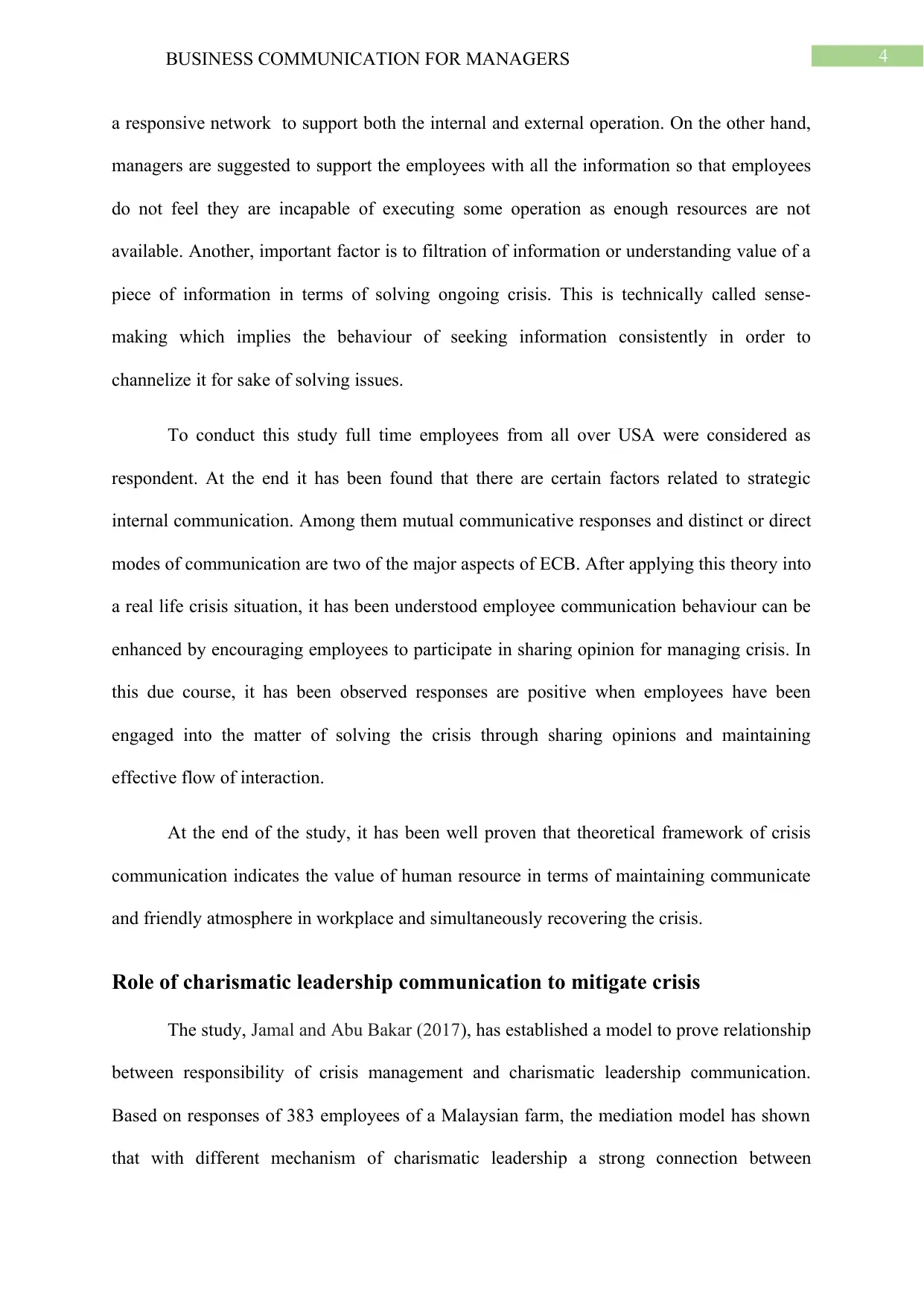
4BUSINESS COMMUNICATION FOR MANAGERS
a responsive network to support both the internal and external operation. On the other hand,
managers are suggested to support the employees with all the information so that employees
do not feel they are incapable of executing some operation as enough resources are not
available. Another, important factor is to filtration of information or understanding value of a
piece of information in terms of solving ongoing crisis. This is technically called sense-
making which implies the behaviour of seeking information consistently in order to
channelize it for sake of solving issues.
To conduct this study full time employees from all over USA were considered as
respondent. At the end it has been found that there are certain factors related to strategic
internal communication. Among them mutual communicative responses and distinct or direct
modes of communication are two of the major aspects of ECB. After applying this theory into
a real life crisis situation, it has been understood employee communication behaviour can be
enhanced by encouraging employees to participate in sharing opinion for managing crisis. In
this due course, it has been observed responses are positive when employees have been
engaged into the matter of solving the crisis through sharing opinions and maintaining
effective flow of interaction.
At the end of the study, it has been well proven that theoretical framework of crisis
communication indicates the value of human resource in terms of maintaining communicate
and friendly atmosphere in workplace and simultaneously recovering the crisis.
Role of charismatic leadership communication to mitigate crisis
The study, Jamal and Abu Bakar (2017), has established a model to prove relationship
between responsibility of crisis management and charismatic leadership communication.
Based on responses of 383 employees of a Malaysian farm, the mediation model has shown
that with different mechanism of charismatic leadership a strong connection between
a responsive network to support both the internal and external operation. On the other hand,
managers are suggested to support the employees with all the information so that employees
do not feel they are incapable of executing some operation as enough resources are not
available. Another, important factor is to filtration of information or understanding value of a
piece of information in terms of solving ongoing crisis. This is technically called sense-
making which implies the behaviour of seeking information consistently in order to
channelize it for sake of solving issues.
To conduct this study full time employees from all over USA were considered as
respondent. At the end it has been found that there are certain factors related to strategic
internal communication. Among them mutual communicative responses and distinct or direct
modes of communication are two of the major aspects of ECB. After applying this theory into
a real life crisis situation, it has been understood employee communication behaviour can be
enhanced by encouraging employees to participate in sharing opinion for managing crisis. In
this due course, it has been observed responses are positive when employees have been
engaged into the matter of solving the crisis through sharing opinions and maintaining
effective flow of interaction.
At the end of the study, it has been well proven that theoretical framework of crisis
communication indicates the value of human resource in terms of maintaining communicate
and friendly atmosphere in workplace and simultaneously recovering the crisis.
Role of charismatic leadership communication to mitigate crisis
The study, Jamal and Abu Bakar (2017), has established a model to prove relationship
between responsibility of crisis management and charismatic leadership communication.
Based on responses of 383 employees of a Malaysian farm, the mediation model has shown
that with different mechanism of charismatic leadership a strong connection between
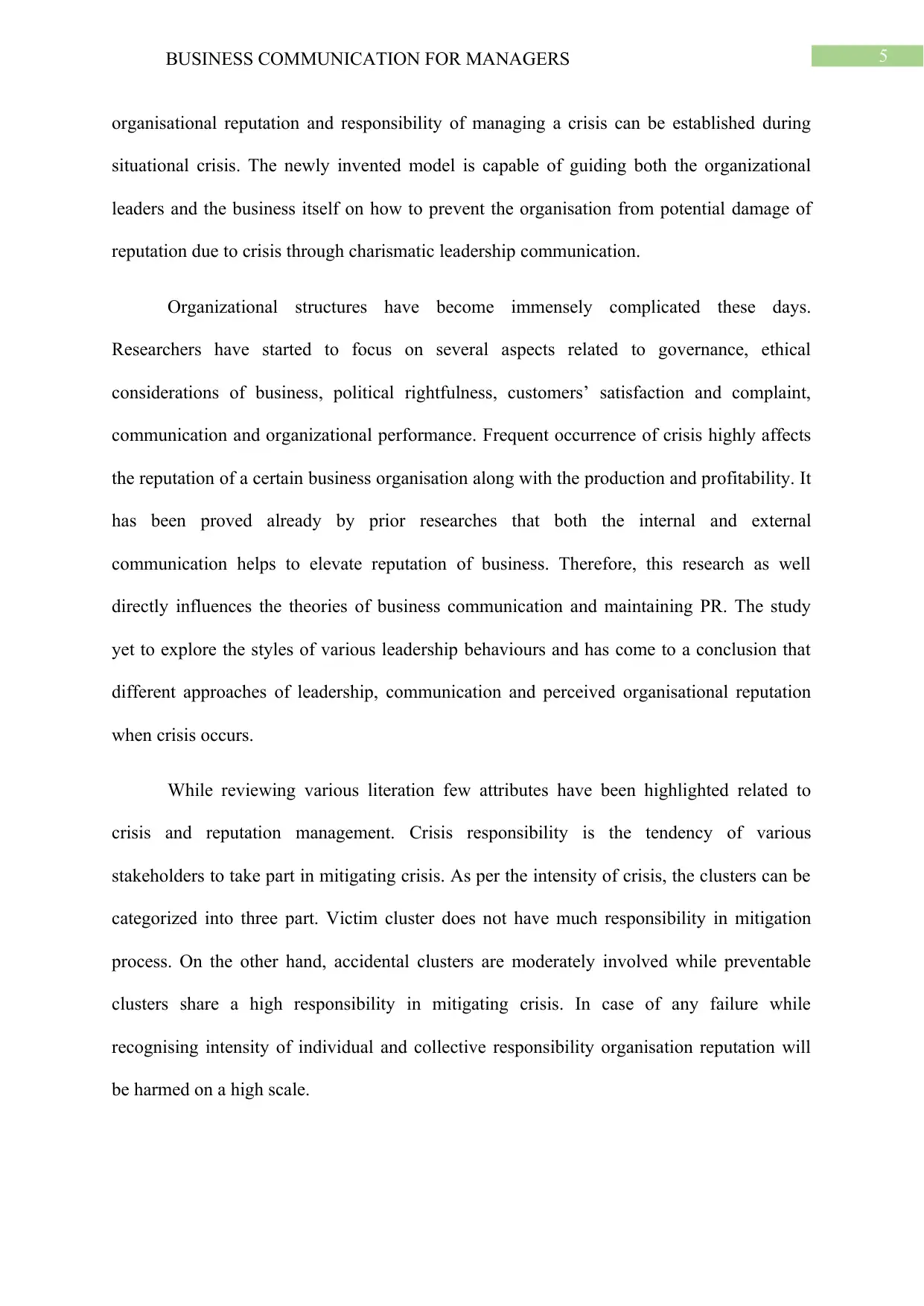
5BUSINESS COMMUNICATION FOR MANAGERS
organisational reputation and responsibility of managing a crisis can be established during
situational crisis. The newly invented model is capable of guiding both the organizational
leaders and the business itself on how to prevent the organisation from potential damage of
reputation due to crisis through charismatic leadership communication.
Organizational structures have become immensely complicated these days.
Researchers have started to focus on several aspects related to governance, ethical
considerations of business, political rightfulness, customers’ satisfaction and complaint,
communication and organizational performance. Frequent occurrence of crisis highly affects
the reputation of a certain business organisation along with the production and profitability. It
has been proved already by prior researches that both the internal and external
communication helps to elevate reputation of business. Therefore, this research as well
directly influences the theories of business communication and maintaining PR. The study
yet to explore the styles of various leadership behaviours and has come to a conclusion that
different approaches of leadership, communication and perceived organisational reputation
when crisis occurs.
While reviewing various literation few attributes have been highlighted related to
crisis and reputation management. Crisis responsibility is the tendency of various
stakeholders to take part in mitigating crisis. As per the intensity of crisis, the clusters can be
categorized into three part. Victim cluster does not have much responsibility in mitigation
process. On the other hand, accidental clusters are moderately involved while preventable
clusters share a high responsibility in mitigating crisis. In case of any failure while
recognising intensity of individual and collective responsibility organisation reputation will
be harmed on a high scale.
organisational reputation and responsibility of managing a crisis can be established during
situational crisis. The newly invented model is capable of guiding both the organizational
leaders and the business itself on how to prevent the organisation from potential damage of
reputation due to crisis through charismatic leadership communication.
Organizational structures have become immensely complicated these days.
Researchers have started to focus on several aspects related to governance, ethical
considerations of business, political rightfulness, customers’ satisfaction and complaint,
communication and organizational performance. Frequent occurrence of crisis highly affects
the reputation of a certain business organisation along with the production and profitability. It
has been proved already by prior researches that both the internal and external
communication helps to elevate reputation of business. Therefore, this research as well
directly influences the theories of business communication and maintaining PR. The study
yet to explore the styles of various leadership behaviours and has come to a conclusion that
different approaches of leadership, communication and perceived organisational reputation
when crisis occurs.
While reviewing various literation few attributes have been highlighted related to
crisis and reputation management. Crisis responsibility is the tendency of various
stakeholders to take part in mitigating crisis. As per the intensity of crisis, the clusters can be
categorized into three part. Victim cluster does not have much responsibility in mitigation
process. On the other hand, accidental clusters are moderately involved while preventable
clusters share a high responsibility in mitigating crisis. In case of any failure while
recognising intensity of individual and collective responsibility organisation reputation will
be harmed on a high scale.
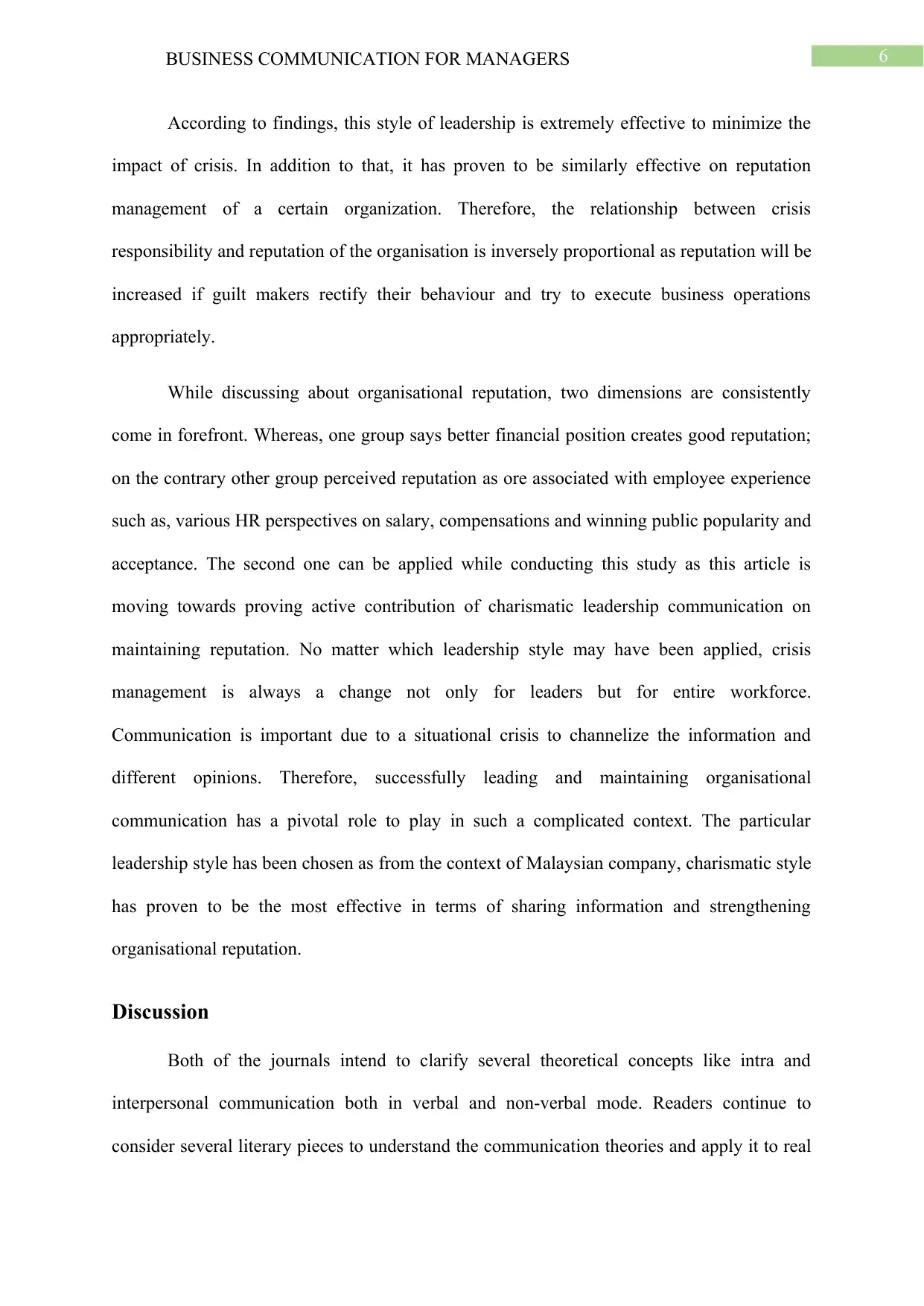
6BUSINESS COMMUNICATION FOR MANAGERS
According to findings, this style of leadership is extremely effective to minimize the
impact of crisis. In addition to that, it has proven to be similarly effective on reputation
management of a certain organization. Therefore, the relationship between crisis
responsibility and reputation of the organisation is inversely proportional as reputation will be
increased if guilt makers rectify their behaviour and try to execute business operations
appropriately.
While discussing about organisational reputation, two dimensions are consistently
come in forefront. Whereas, one group says better financial position creates good reputation;
on the contrary other group perceived reputation as ore associated with employee experience
such as, various HR perspectives on salary, compensations and winning public popularity and
acceptance. The second one can be applied while conducting this study as this article is
moving towards proving active contribution of charismatic leadership communication on
maintaining reputation. No matter which leadership style may have been applied, crisis
management is always a change not only for leaders but for entire workforce.
Communication is important due to a situational crisis to channelize the information and
different opinions. Therefore, successfully leading and maintaining organisational
communication has a pivotal role to play in such a complicated context. The particular
leadership style has been chosen as from the context of Malaysian company, charismatic style
has proven to be the most effective in terms of sharing information and strengthening
organisational reputation.
Discussion
Both of the journals intend to clarify several theoretical concepts like intra and
interpersonal communication both in verbal and non-verbal mode. Readers continue to
consider several literary pieces to understand the communication theories and apply it to real
According to findings, this style of leadership is extremely effective to minimize the
impact of crisis. In addition to that, it has proven to be similarly effective on reputation
management of a certain organization. Therefore, the relationship between crisis
responsibility and reputation of the organisation is inversely proportional as reputation will be
increased if guilt makers rectify their behaviour and try to execute business operations
appropriately.
While discussing about organisational reputation, two dimensions are consistently
come in forefront. Whereas, one group says better financial position creates good reputation;
on the contrary other group perceived reputation as ore associated with employee experience
such as, various HR perspectives on salary, compensations and winning public popularity and
acceptance. The second one can be applied while conducting this study as this article is
moving towards proving active contribution of charismatic leadership communication on
maintaining reputation. No matter which leadership style may have been applied, crisis
management is always a change not only for leaders but for entire workforce.
Communication is important due to a situational crisis to channelize the information and
different opinions. Therefore, successfully leading and maintaining organisational
communication has a pivotal role to play in such a complicated context. The particular
leadership style has been chosen as from the context of Malaysian company, charismatic style
has proven to be the most effective in terms of sharing information and strengthening
organisational reputation.
Discussion
Both of the journals intend to clarify several theoretical concepts like intra and
interpersonal communication both in verbal and non-verbal mode. Readers continue to
consider several literary pieces to understand the communication theories and apply it to real
Paraphrase This Document
Need a fresh take? Get an instant paraphrase of this document with our AI Paraphraser
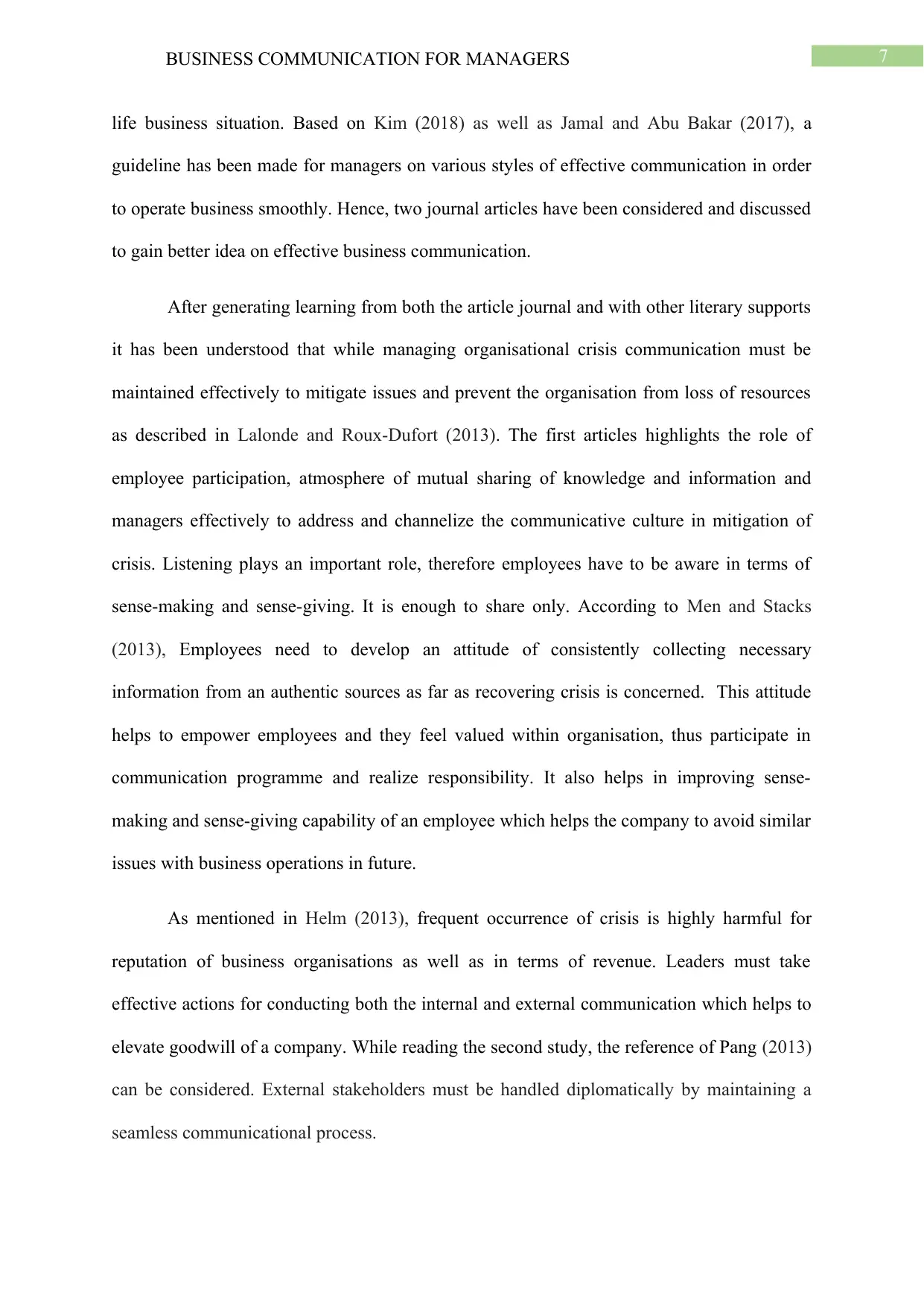
7BUSINESS COMMUNICATION FOR MANAGERS
life business situation. Based on Kim (2018) as well as Jamal and Abu Bakar (2017), a
guideline has been made for managers on various styles of effective communication in order
to operate business smoothly. Hence, two journal articles have been considered and discussed
to gain better idea on effective business communication.
After generating learning from both the article journal and with other literary supports
it has been understood that while managing organisational crisis communication must be
maintained effectively to mitigate issues and prevent the organisation from loss of resources
as described in Lalonde and Roux-Dufort (2013). The first articles highlights the role of
employee participation, atmosphere of mutual sharing of knowledge and information and
managers effectively to address and channelize the communicative culture in mitigation of
crisis. Listening plays an important role, therefore employees have to be aware in terms of
sense-making and sense-giving. It is enough to share only. According to Men and Stacks
(2013), Employees need to develop an attitude of consistently collecting necessary
information from an authentic sources as far as recovering crisis is concerned. This attitude
helps to empower employees and they feel valued within organisation, thus participate in
communication programme and realize responsibility. It also helps in improving sense-
making and sense-giving capability of an employee which helps the company to avoid similar
issues with business operations in future.
As mentioned in Helm (2013), frequent occurrence of crisis is highly harmful for
reputation of business organisations as well as in terms of revenue. Leaders must take
effective actions for conducting both the internal and external communication which helps to
elevate goodwill of a company. While reading the second study, the reference of Pang (2013)
can be considered. External stakeholders must be handled diplomatically by maintaining a
seamless communicational process.
life business situation. Based on Kim (2018) as well as Jamal and Abu Bakar (2017), a
guideline has been made for managers on various styles of effective communication in order
to operate business smoothly. Hence, two journal articles have been considered and discussed
to gain better idea on effective business communication.
After generating learning from both the article journal and with other literary supports
it has been understood that while managing organisational crisis communication must be
maintained effectively to mitigate issues and prevent the organisation from loss of resources
as described in Lalonde and Roux-Dufort (2013). The first articles highlights the role of
employee participation, atmosphere of mutual sharing of knowledge and information and
managers effectively to address and channelize the communicative culture in mitigation of
crisis. Listening plays an important role, therefore employees have to be aware in terms of
sense-making and sense-giving. It is enough to share only. According to Men and Stacks
(2013), Employees need to develop an attitude of consistently collecting necessary
information from an authentic sources as far as recovering crisis is concerned. This attitude
helps to empower employees and they feel valued within organisation, thus participate in
communication programme and realize responsibility. It also helps in improving sense-
making and sense-giving capability of an employee which helps the company to avoid similar
issues with business operations in future.
As mentioned in Helm (2013), frequent occurrence of crisis is highly harmful for
reputation of business organisations as well as in terms of revenue. Leaders must take
effective actions for conducting both the internal and external communication which helps to
elevate goodwill of a company. While reading the second study, the reference of Pang (2013)
can be considered. External stakeholders must be handled diplomatically by maintaining a
seamless communicational process.
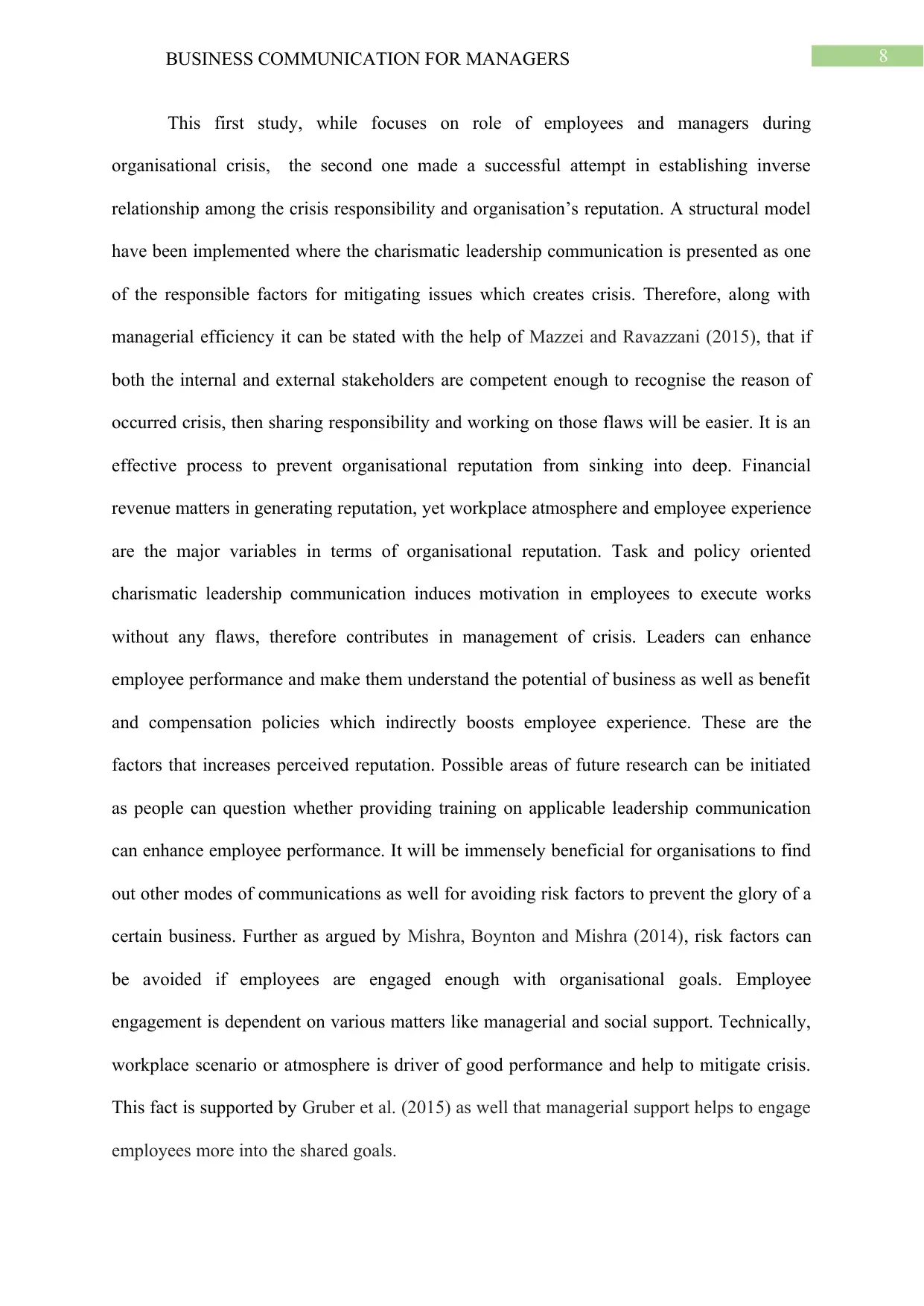
8BUSINESS COMMUNICATION FOR MANAGERS
This first study, while focuses on role of employees and managers during
organisational crisis, the second one made a successful attempt in establishing inverse
relationship among the crisis responsibility and organisation’s reputation. A structural model
have been implemented where the charismatic leadership communication is presented as one
of the responsible factors for mitigating issues which creates crisis. Therefore, along with
managerial efficiency it can be stated with the help of Mazzei and Ravazzani (2015), that if
both the internal and external stakeholders are competent enough to recognise the reason of
occurred crisis, then sharing responsibility and working on those flaws will be easier. It is an
effective process to prevent organisational reputation from sinking into deep. Financial
revenue matters in generating reputation, yet workplace atmosphere and employee experience
are the major variables in terms of organisational reputation. Task and policy oriented
charismatic leadership communication induces motivation in employees to execute works
without any flaws, therefore contributes in management of crisis. Leaders can enhance
employee performance and make them understand the potential of business as well as benefit
and compensation policies which indirectly boosts employee experience. These are the
factors that increases perceived reputation. Possible areas of future research can be initiated
as people can question whether providing training on applicable leadership communication
can enhance employee performance. It will be immensely beneficial for organisations to find
out other modes of communications as well for avoiding risk factors to prevent the glory of a
certain business. Further as argued by Mishra, Boynton and Mishra (2014), risk factors can
be avoided if employees are engaged enough with organisational goals. Employee
engagement is dependent on various matters like managerial and social support. Technically,
workplace scenario or atmosphere is driver of good performance and help to mitigate crisis.
This fact is supported by Gruber et al. (2015) as well that managerial support helps to engage
employees more into the shared goals.
This first study, while focuses on role of employees and managers during
organisational crisis, the second one made a successful attempt in establishing inverse
relationship among the crisis responsibility and organisation’s reputation. A structural model
have been implemented where the charismatic leadership communication is presented as one
of the responsible factors for mitigating issues which creates crisis. Therefore, along with
managerial efficiency it can be stated with the help of Mazzei and Ravazzani (2015), that if
both the internal and external stakeholders are competent enough to recognise the reason of
occurred crisis, then sharing responsibility and working on those flaws will be easier. It is an
effective process to prevent organisational reputation from sinking into deep. Financial
revenue matters in generating reputation, yet workplace atmosphere and employee experience
are the major variables in terms of organisational reputation. Task and policy oriented
charismatic leadership communication induces motivation in employees to execute works
without any flaws, therefore contributes in management of crisis. Leaders can enhance
employee performance and make them understand the potential of business as well as benefit
and compensation policies which indirectly boosts employee experience. These are the
factors that increases perceived reputation. Possible areas of future research can be initiated
as people can question whether providing training on applicable leadership communication
can enhance employee performance. It will be immensely beneficial for organisations to find
out other modes of communications as well for avoiding risk factors to prevent the glory of a
certain business. Further as argued by Mishra, Boynton and Mishra (2014), risk factors can
be avoided if employees are engaged enough with organisational goals. Employee
engagement is dependent on various matters like managerial and social support. Technically,
workplace scenario or atmosphere is driver of good performance and help to mitigate crisis.
This fact is supported by Gruber et al. (2015) as well that managerial support helps to engage
employees more into the shared goals.

9BUSINESS COMMUNICATION FOR MANAGERS
Secure Best Marks with AI Grader
Need help grading? Try our AI Grader for instant feedback on your assignments.
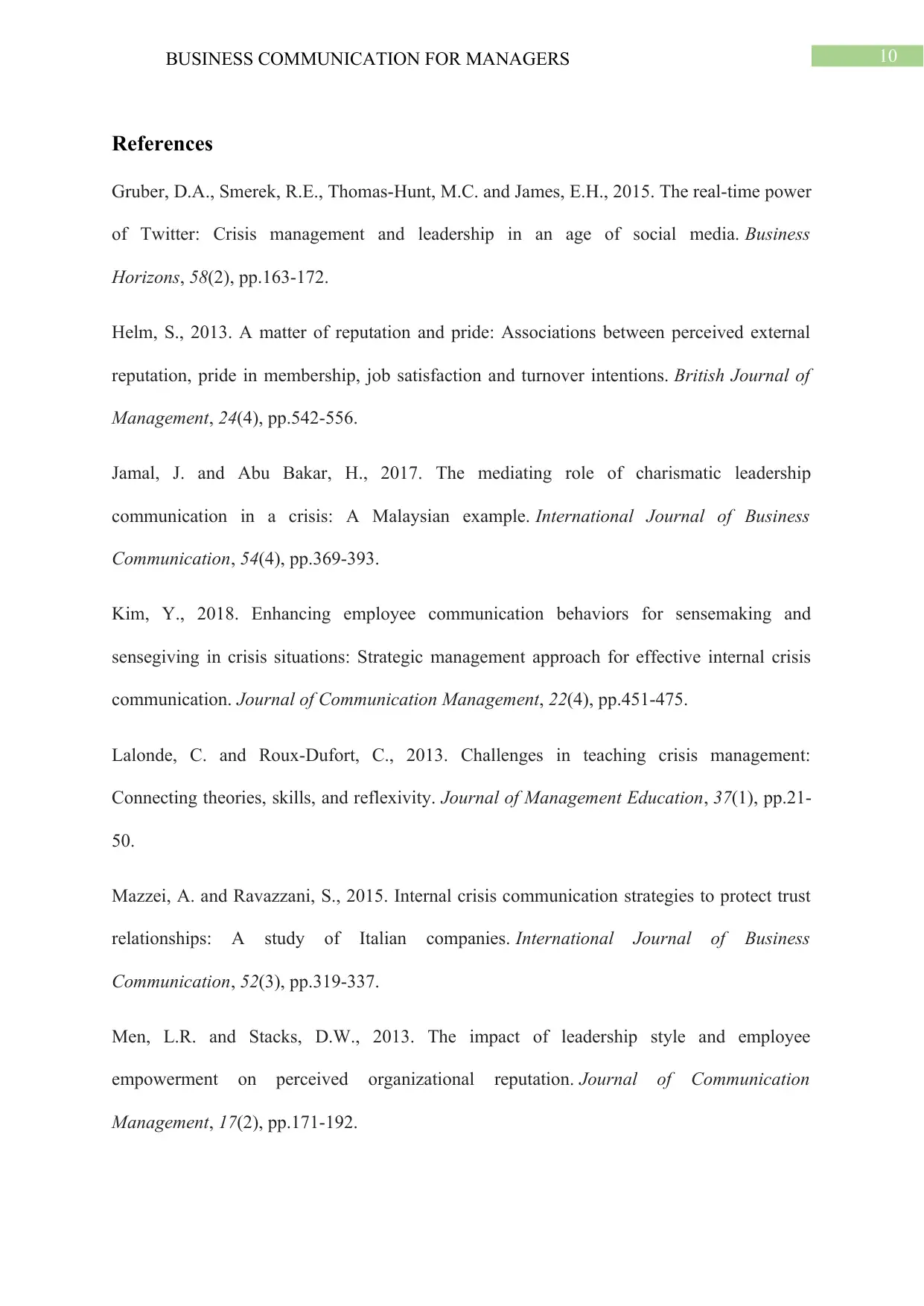
10BUSINESS COMMUNICATION FOR MANAGERS
References
Gruber, D.A., Smerek, R.E., Thomas-Hunt, M.C. and James, E.H., 2015. The real-time power
of Twitter: Crisis management and leadership in an age of social media. Business
Horizons, 58(2), pp.163-172.
Helm, S., 2013. A matter of reputation and pride: Associations between perceived external
reputation, pride in membership, job satisfaction and turnover intentions. British Journal of
Management, 24(4), pp.542-556.
Jamal, J. and Abu Bakar, H., 2017. The mediating role of charismatic leadership
communication in a crisis: A Malaysian example. International Journal of Business
Communication, 54(4), pp.369-393.
Kim, Y., 2018. Enhancing employee communication behaviors for sensemaking and
sensegiving in crisis situations: Strategic management approach for effective internal crisis
communication. Journal of Communication Management, 22(4), pp.451-475.
Lalonde, C. and Roux-Dufort, C., 2013. Challenges in teaching crisis management:
Connecting theories, skills, and reflexivity. Journal of Management Education, 37(1), pp.21-
50.
Mazzei, A. and Ravazzani, S., 2015. Internal crisis communication strategies to protect trust
relationships: A study of Italian companies. International Journal of Business
Communication, 52(3), pp.319-337.
Men, L.R. and Stacks, D.W., 2013. The impact of leadership style and employee
empowerment on perceived organizational reputation. Journal of Communication
Management, 17(2), pp.171-192.
References
Gruber, D.A., Smerek, R.E., Thomas-Hunt, M.C. and James, E.H., 2015. The real-time power
of Twitter: Crisis management and leadership in an age of social media. Business
Horizons, 58(2), pp.163-172.
Helm, S., 2013. A matter of reputation and pride: Associations between perceived external
reputation, pride in membership, job satisfaction and turnover intentions. British Journal of
Management, 24(4), pp.542-556.
Jamal, J. and Abu Bakar, H., 2017. The mediating role of charismatic leadership
communication in a crisis: A Malaysian example. International Journal of Business
Communication, 54(4), pp.369-393.
Kim, Y., 2018. Enhancing employee communication behaviors for sensemaking and
sensegiving in crisis situations: Strategic management approach for effective internal crisis
communication. Journal of Communication Management, 22(4), pp.451-475.
Lalonde, C. and Roux-Dufort, C., 2013. Challenges in teaching crisis management:
Connecting theories, skills, and reflexivity. Journal of Management Education, 37(1), pp.21-
50.
Mazzei, A. and Ravazzani, S., 2015. Internal crisis communication strategies to protect trust
relationships: A study of Italian companies. International Journal of Business
Communication, 52(3), pp.319-337.
Men, L.R. and Stacks, D.W., 2013. The impact of leadership style and employee
empowerment on perceived organizational reputation. Journal of Communication
Management, 17(2), pp.171-192.
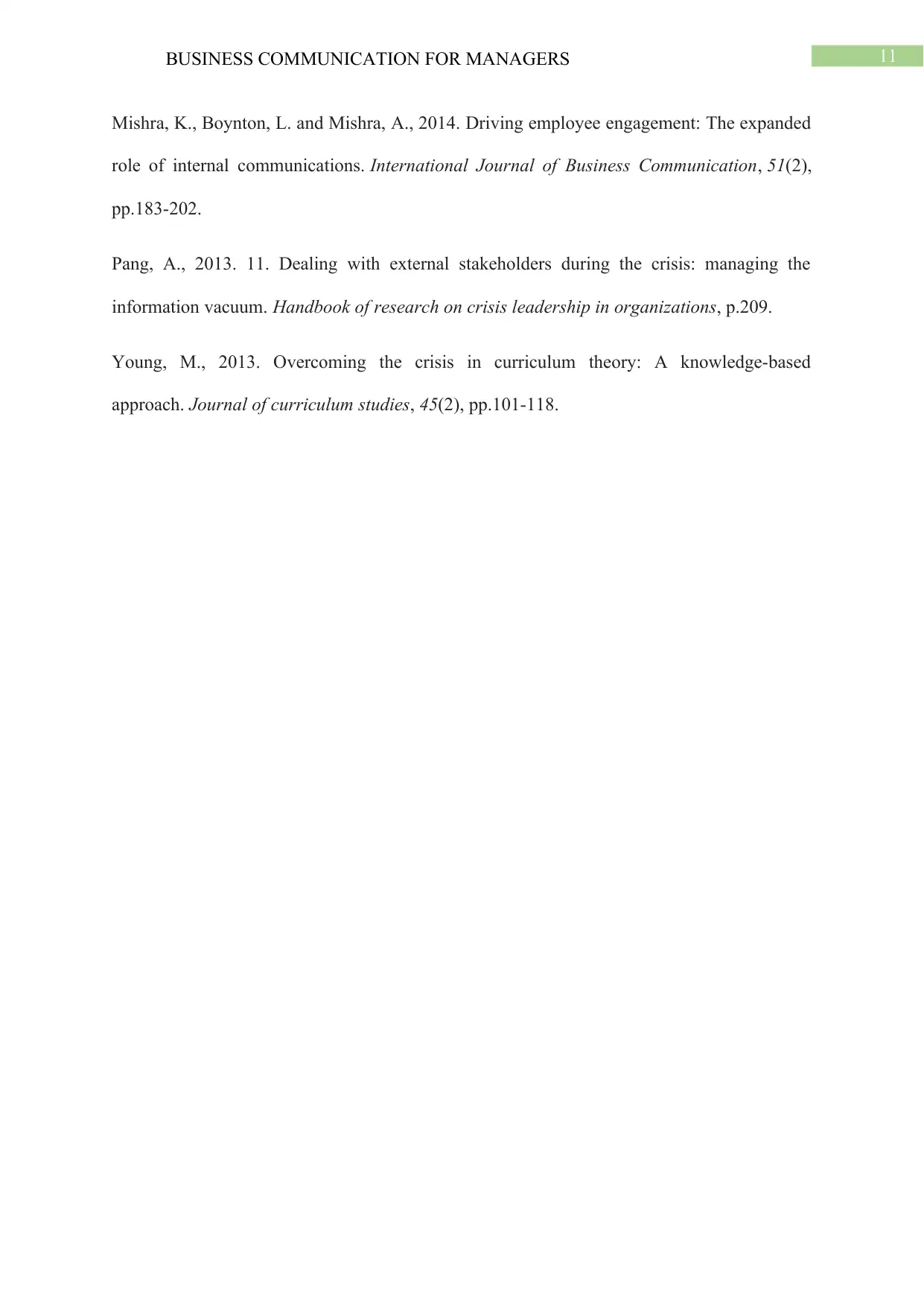
11BUSINESS COMMUNICATION FOR MANAGERS
Mishra, K., Boynton, L. and Mishra, A., 2014. Driving employee engagement: The expanded
role of internal communications. International Journal of Business Communication, 51(2),
pp.183-202.
Pang, A., 2013. 11. Dealing with external stakeholders during the crisis: managing the
information vacuum. Handbook of research on crisis leadership in organizations, p.209.
Young, M., 2013. Overcoming the crisis in curriculum theory: A knowledge-based
approach. Journal of curriculum studies, 45(2), pp.101-118.
Mishra, K., Boynton, L. and Mishra, A., 2014. Driving employee engagement: The expanded
role of internal communications. International Journal of Business Communication, 51(2),
pp.183-202.
Pang, A., 2013. 11. Dealing with external stakeholders during the crisis: managing the
information vacuum. Handbook of research on crisis leadership in organizations, p.209.
Young, M., 2013. Overcoming the crisis in curriculum theory: A knowledge-based
approach. Journal of curriculum studies, 45(2), pp.101-118.
1 out of 12
Related Documents
Your All-in-One AI-Powered Toolkit for Academic Success.
+13062052269
info@desklib.com
Available 24*7 on WhatsApp / Email
![[object Object]](/_next/static/media/star-bottom.7253800d.svg)
Unlock your academic potential
© 2024 | Zucol Services PVT LTD | All rights reserved.




